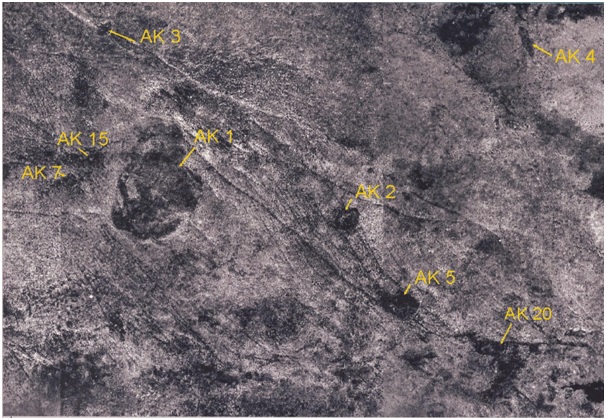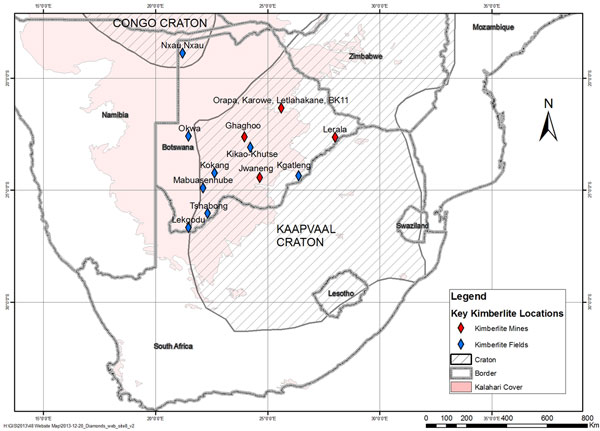History of Diamond Exploration in Botswana
De Beers began prospecting for diamonds in the then Bechuanaland Protectorate in 1954. The legendary Gavin Lamont joined Kimberlitic Searches, the local De Beers Company in 1955, after working for the Botswana Geological Survey. His first exploration programme was in the Tuli Block along the Limpopo River.
Before De Beers began this work, no systematic diamond prospecting had been conducted in Botswana. Central African Selection Trust (CAST) was the only other company exploring for diamonds at that time and in 1959 they found three small diamonds (0.2, 0.14 and 0.02 carat) in gravels associated with the Motloutse River close to Foley Siding. CAST believed that these stones had been derived from the disintegration of the basal Karoo conglomerates and relinquished the ground. De Beers then applied for the Bamangwato tribal territory and began work there in 1962. They confirmed the CAST's results when they found a 0.50 carat stone and a 2.39 carat octahedron diamond as well as kimberlitic garnets along the same river.
South Africa's well known geologist Alex du Toit had published the idea of crustal warping in 1933. Lamont, who had known Du Toit from his University days, recognised the importance of this concept and applied this to the diamond finds along the Motloutse River in search for the primary sources. He suggested that the source of these diamonds could lie far to the west, having been transported from such a source by a palaeo-Motloutse River now decapitated by a one of Du Toit' crustal up warps.
At more or less the same time Lamont changed from using gold pans, as a means of concentrating soil samples, to gravitating screens. The process of using classifying screens to size sand grains from about 2 mm down to 0.5 mm before the gravitating process was much more effective that using gold pans on unclassified material. Sand grains from the Kalahari sediments generally range in size from about 2 mm down to 0.3 mm, and an experienced hand-gravitating operator can recover about 90% of the ilmenites and 80% of the garnets in the 0.5 to 2.0 mm size range.
In 1966, after eleven years of prospecting, De Beers found the first two 'kimberlites' near Mochudi in the Kgatleng District. Although not true kimberlites but rather lamprophyres (para-kimberlites) they contain ilmenite and it proved that the sampling technique was effective.
After this initial technical success Lamont targeted an area around Letlhakane south of the Makgadikgadi Pan where the Kalahari sand cover is fairly thin. A rapid reconnaissance scoop sampling programme was undertaken later in 1966, taking sampling along as many roads and tracks as possible. They covered the area in about three days and then returned to a small pan which had some water left from the summer rains to hand-gravitate these samples and found the first kimberlitic garnets and ilmenites of the Letlhakane-Orapa kimberlite province in practically all them.
Several north-south baselines and access roads were cut across map sheets 2125A and 2125B. Geologist Manfred Marx, fresh out of university, began a programme of reconnaissance soil sampling, working from east to west. By January 1967, he was finding abundant ilmenites in his reconnaissance soil samples, and on the 1
st March, he discovered the first true kimberlite in Botswana - 2125-B/K1 or BK1. This was followed on 17
th March by BK2 and then on 25
th April the Orapa pipe -- AK1. It was a massive intrusive body, which showed up as an oval feature of over 100 hectares on the aerial photographs. It was said that South African Airways pilots used it as navigation landmark on their flights to Europe (Fig. 1).
 Figure 1. Aerial photo of the Orapa kimberlite cluster prior its discovery.
Figure 1. Aerial photo of the Orapa kimberlite cluster prior its discovery.
Letlhakane, or DK1, was discovered in June 1969, followed by AK6 (now Karowe), BK09, BK12, BK15 and part of BK01 (all four now part of the Damtchaa Mine) in 1970 and BK11 in 1974.
De Beers continued with a programme of reconnaissance soil-sampling using scoop sampling between baselines. By the end of 1969, De Beers reported the first definite and 'probable' kimberlitic ilmenites from reconnaissance soil samples taken over 150 square miles across the Kweneng\Ngwaketse boundary, and are considered to be the first indication of the Jwaneng kimberlite province.
The Orapa pipe outcropped on surface and the garnet and ilmenite anomalies there were clear and confined to the kimberlite pipes, while at Jwaneng with approximately 50 to 60 m of Kalahari cover the anomalies were much more diffuse and spread over much larger areas. Stuart Vercoe and Norman Lock were involved in follow-up sampling to try to define drill targets below the Kalahari sediments. Ground magnetics was not effective since the Jwaneng pipes were in general weakly magnetic. So with the use of a small Vole drill they intersected kimberlite and this culminated in the discovery of the Jwaneng kimberlite in 1972.
In the side wall of the mine it is possible to see small burrows in the weathered kimberlite and the overlying 50 metres of Kalahari sediments that were made by termites. These insects burrowed down to get water and moist clay with which they build their large termite mounds on surface and at the same time bringing up the small garnets and ilmenites from the kimberlite. It is these mineral grains, especially the more weather resistant ilmenite, that are picked-up in the loam samples which ultimately leads the geologists to the buried kimberlite pipes.
Other companies started to explore in Botswana and in 1977 Falconbridge used airborne geophysical technology over areas that had proven to be positive with regard to kimberlitic indicator minerals from previous De Beers sampling programs. They covered two such areas near Tshabong and Kukong and found many aeromagnetic targets to investigate. Under the guidance of Chris Jennings Falconbridge discovered some 40 kimberlites in the Tshabong area and 21 in the Kukong area. Based on those early technical successes Falconbridge, with their joint venture partner Superior Oil, started regional soil sampling programmes themselves. Based on the recovery of two ilmenites in the Central Kalahari Game Reserve, they flew an airborne magnetic survey and in 1981 found Go25 (Gope or Ghaghoo as it is now called). Construction of a mine over this kimberlite is presently in process by Gem Diamonds.
In July 1988, De Beers covered the Lerala area in east Botswana with reconnaissance loam sampling. After the initial positive results from the reconnaissance program, Grid Loam Sampling (DGL) and Detailed Grid Loam Sampling (DGLS) led to the discovery of two kimberlites clusters in 1991: one comprising three pipes (K1, K7 and K8) close to the Lotsane River, and the other five pipes (K2, K3, K4, K5 and K6) near the Susulela River. It is the latter group of kimberlites that proved diamondiferous and has been subjected to several trial mining operations.
The former cluster produced very few garnets, is diamond-poor but dominated by ilmenite. The diamondiferous kimberlites are garnet-bearing and ilmenite-poor. Interestingly the samples, which eventually led to the discovery of the two groups of kimberlites, were rich in ilmenite that came from the first cluster.
Since the discovery of the first kimberlite in Botswana in 1967, a total of 386 kimberlites have been found mainly associated with 12 kimberlite clusters (Fig. 2). Of these 16 kimberlites from four clusters have produced or are producing diamonds, and these are: Orapa (AK1, Karowe-AK6, Letlhakane-DK1 & DK2, BK11, Damtshaa-BK1, BK9, BK12 & BK15), Ghaghoo (Go-25), Jwaneng (DK2), and Lerala (K2, K3, K4, K5 and K6).
 Figure 2. Distribution of diamond mines and other kimberlites in Botswana
Figure 2. Distribution of diamond mines and other kimberlites in Botswana
Typically, these would produce around 28.8 million carats per annum of which 26 million would come from the two big Orapa AK1 and Jwaneng DK2 mines. The Letlhakane mine produces approximately 1 million carats per annum and the remaining 1.8 million carats from the other 12 kimberlites combined. This emphasises the importance of the two large producing kimberlites not only in Botswana but also globally.
Globally the first kimberlites to be mined were the Jagersfontein and Kimberley Mines in South Africa, in 1870 and 1871 respectively. The latter is probably better known as the Big Hole.
Between 1870 and 2012, the world has produced some 4,898 million carats, mostly from kimberlites. Botswana, which has only been producing diamonds since 1971, one hundred years after the Big Hole, has provided 665 million carats of this global figure which represents 14% of all diamonds ever produced, and this is almost the same as what South Africa has produced (680 million carats) since 1870. However, the Botswana figure will increase significantly in the future as many of the other global producers are reaching the end of their lives and no new major discoveries have been made in the last two decades.
Finally, since the economic downturn most producers have reduced their output and in 2011 the world generated 124 million carats valued at 14.4 billion US$. Botswana was responsible for 23 million of those carats (18.5 %) which were valued at 3.9 billion US$ or 27% of the total value.
In 2011, De Beers announced that it would shift its rough diamond trading operation from London to Gaborone. The move which was completed in 2013 is expected to bring an extra $6 billion of diamond sales into the country establishing Botswana as one of the world's key diamond centers.



